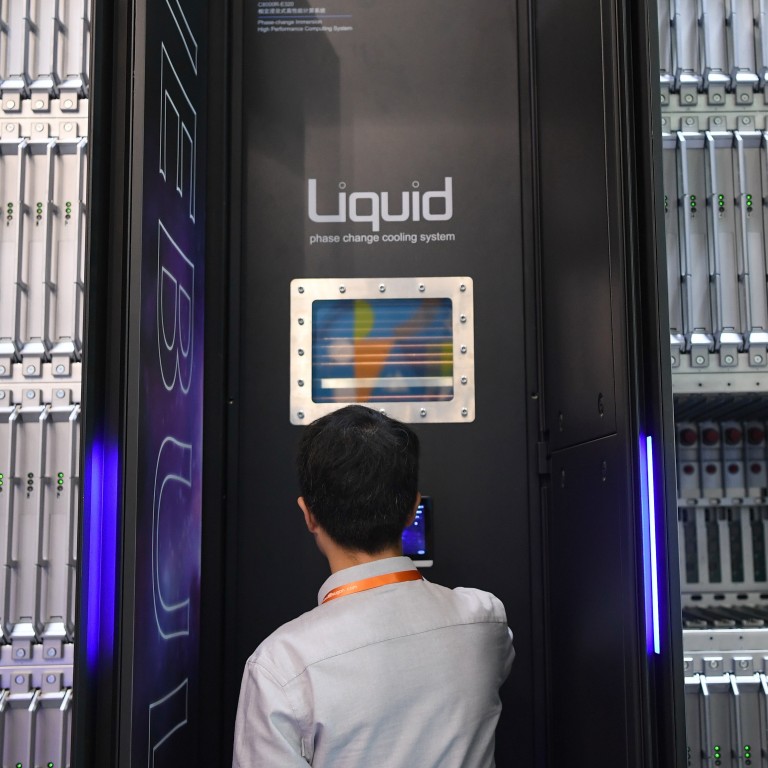
Explainer | What you need to know about the Chinese supercomputer firms added to US trade blacklist
- China dominates the Top 500 supercomputer list with 219 systems, or 43.8 per cent of the total, followed by the US with 116
First it was China’s telecommunications champion Huawei Technologies. Now it is China’s developers of supercomputers that have found themselves in Washington’s cross hairs, after the US Commerce Department on Friday added them to the Entity List, which effectively bars them from purchasing American technology.
The department said it was adding Sugon, the Wuxi Jiangnan Institute of Computing Technology, Higon, Chengdu Haiguang Integrated Circuit and Chengdu Haiguang Microelectronics Technology – along with numerous aliases of the five entities – to the list over concerns about military applications of the supercomputers they are developing.
The move comes ahead of US President Donald Trump and Chinese President Xi Jinping’s meeting during the G20 summit in Japan this week, and as China and the US vie to produce the first exascale computer, a next-generation machine capable of one quintillion – or a billion billion – calculations a second.
Supercomputing has become an emblem of technological might as it can be applied to sensitive areas such as nuclear weapons development, encryption and missile defence, among others. Currently, the US has the world’s two fastest supercomputers, followed by a Chinese-built computer in third place.
“[The US ban] will stall China’s move into next-generation supercomputing, but will not be able to restrain its rise as the country’s key supercomputing projects now use home-developed chips and technologies,” said An Hong, professor of computer science at the University of Science and Technology of China in Hefei, capital of eastern China’s Anhui province.
China fails to wrest supercomputer crown from US amid tech tensions
1. Which companies have been added to the US Entity List and why are they important?
Sugon, officially known as Dawning Information Industry Co, is a leading Chinese company in the field of high-performance computing (HPC), servers, storage, cloud-computing and big data. Sugon was the first company to bring China into the global top 3 for supercomputing. Backed by the Chinese Academy of Sciences, Sugon has held pole position in China’s Top 100 rankings for HPC by market share for eight consecutive years, from 2009 to 2016, according to its website.
Sugon supercomputers support the State Grid Corporation of China, which runs China’s electric grid. It also cooperates with China Mobile, the world’s largest wireless network operator, and the China Meteorological Administration. It also supplies data centres for hi-tech companies such as e-commerce giant JD.com and ByteDance, operator of the global short-form video app hit TikTok.
Established in 2016, Higon is a fabless semiconductor company that designs and sells advanced integrated circuits and server processor chips for the Chinese market. In 2016, Higon entered into a joint-venture with US semiconductor firm Advanced Micro Devices (AMD) to develop chips for servers.
The US identified Sugon as Higon’s majority owner. It also said Higon has an ownership interest in Chengdu Haiguang Integrated Circuit and Chengdu Haiguang Microelectronics Technology.
Wuxi Jiangnan Institute of Computing Technology is owned by the 56th Research Institute of the General Staff of China’s People’s Liberation Army. That institute’s mission, according to the US Commerce Department, is “to support China’s military modernisation”. The institute, established in June 1951, is the earliest large-scale integrated computing technology institute combining computer science and engineering.
2. What have the companies said in response?
Sugon, which heavily relies on chips from US technology firms, including AMD, Intel and Nvidia, is expected to take a hit from the export restriction. In a statement Sugon filed with the Shanghai Stock Exchange on Monday, the company said it had suspended trading and would resume trading on July 1 at the latest. “We are verifying relevant content and comprehensively evaluating the impact of the ban and making preparations,” said the statement. “We will be well-prepared and keep active communication with all parties.”
Email inquiries sent to the other four companies on the entity list did not receive an immediate response.
US announces supercomputer plan as rivalry hots up with China
3. What is the Entity List and how might it impact China’s supercomputers?
The Entity List identifies organisations and individuals believed to be involved in, or pose a significant risk of becoming involved in, activities contrary to America’s national security or foreign policy interests. Those on the list require a US licence to purchase, re-export or transfer software and other technologies from US companies. In 2015, the Commerce Department put four Chinese supercomputing organisations on the list, including China’s National University of Defence Technology (NUDT) “because of its use of US-origin multicores, boards, and (co) processors to power supercomputers believed to support nuclear explosive simulation and military simulation activities”. Since then, NUDT, which developed China’s Tianhe (Milkyway) supercomputer systems, has procured US items under an alias, the department found.
The National Supercomputing Centre of Guangzhou, which operates the Tianhe-2, designated the world’s fastest supercomputer between 2013 and 2015, was also on the blacklist.
4. Which country is ahead in the race for supercomputing dominance?
China lost its leadership in supercomputing after the US took top spot for the fastest supercomputer in 2018, ending China’s five-year dominance. According to the latest Top 500 list released earlier this month, Summit and Sierra, two IBM-built supercomputers, maintained their top positions for the US, followed by two Chinese systems, the Sunway TaihuLight and the Tianhe-2A, which are installed in Wuxi and Guangzhou, respectively. China, however, continues to dominate in terms of the number of ranked supercomputing systems in the Top500 list, which is issued twice a year. China tops the supercomputer list with 219 systems, or 43.8 per cent of the total, followed by the US with 116.


